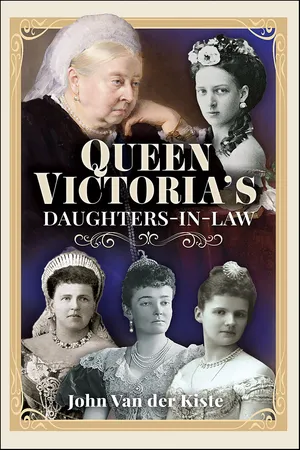
- 232 pages
- English
- ePUB (mobile friendly)
- Available on iOS & Android
eBook - ePub
Queen Victoria's Daughters-in-Law
About this book
The first book to study the four wives of Queen Victoria's sons as a family group—based partly on previously unpublished material from the Royal Archives.
The first to join the family of the "Grandmama of Europe" was Alexandra, eldest daughter of the prince about to become King Christian IX of Denmark. Charming, ever sympathetic and widely considered one of the most attractive royal women of her time, she was prematurely deaf and suffered from a limp which was made fashionable by court ladies due to her popularity. Alexandra proved an ideal wife for the Prince of Wales, later King Edward VII.
Grand Duchess Marie, daughter of Tsar Alexander II of Russia and wife of Alfred, Duke of Edinburgh and later Saxe-Coburg Gotha, was cultured and intelligent, but dowdy, haughty and, convinced of the Romanovs' superiority, resented having to give precedence at court to her in-laws. Louise of Prussia, a niece of William I, German Emperor, had the good fortune to escape from a miserable family life in Berlin and marry Arthur, Duke of Connaught, a dedicated army officer who was always the Queen's favorite among her children.
Finally, Helen of Waldeck-Pyrmont, sister of Emma, Queen Consort of the Netherlands, became the wife of the cultured Leopold, Duke of Albany, but he was hemophiliac and their marriage was destined to be the briefest of all, cut short by his sudden death less than three years later.
All four were very different personalities, proved themselves to be supportive wives, mothers and daughters-in-law in their own way, and dedicated workers for charity at home and abroad.
The first to join the family of the "Grandmama of Europe" was Alexandra, eldest daughter of the prince about to become King Christian IX of Denmark. Charming, ever sympathetic and widely considered one of the most attractive royal women of her time, she was prematurely deaf and suffered from a limp which was made fashionable by court ladies due to her popularity. Alexandra proved an ideal wife for the Prince of Wales, later King Edward VII.
Grand Duchess Marie, daughter of Tsar Alexander II of Russia and wife of Alfred, Duke of Edinburgh and later Saxe-Coburg Gotha, was cultured and intelligent, but dowdy, haughty and, convinced of the Romanovs' superiority, resented having to give precedence at court to her in-laws. Louise of Prussia, a niece of William I, German Emperor, had the good fortune to escape from a miserable family life in Berlin and marry Arthur, Duke of Connaught, a dedicated army officer who was always the Queen's favorite among her children.
Finally, Helen of Waldeck-Pyrmont, sister of Emma, Queen Consort of the Netherlands, became the wife of the cultured Leopold, Duke of Albany, but he was hemophiliac and their marriage was destined to be the briefest of all, cut short by his sudden death less than three years later.
All four were very different personalities, proved themselves to be supportive wives, mothers and daughters-in-law in their own way, and dedicated workers for charity at home and abroad.
Frequently asked questions
Yes, you can cancel anytime from the Subscription tab in your account settings on the Perlego website. Your subscription will stay active until the end of your current billing period. Learn how to cancel your subscription.
No, books cannot be downloaded as external files, such as PDFs, for use outside of Perlego. However, you can download books within the Perlego app for offline reading on mobile or tablet. Learn more here.
Perlego offers two plans: Essential and Complete
- Essential is ideal for learners and professionals who enjoy exploring a wide range of subjects. Access the Essential Library with 800,000+ trusted titles and best-sellers across business, personal growth, and the humanities. Includes unlimited reading time and Standard Read Aloud voice.
- Complete: Perfect for advanced learners and researchers needing full, unrestricted access. Unlock 1.4M+ books across hundreds of subjects, including academic and specialized titles. The Complete Plan also includes advanced features like Premium Read Aloud and Research Assistant.
We are an online textbook subscription service, where you can get access to an entire online library for less than the price of a single book per month. With over 1 million books across 1000+ topics, we’ve got you covered! Learn more here.
Look out for the read-aloud symbol on your next book to see if you can listen to it. The read-aloud tool reads text aloud for you, highlighting the text as it is being read. You can pause it, speed it up and slow it down. Learn more here.
Yes! You can use the Perlego app on both iOS or Android devices to read anytime, anywhere — even offline. Perfect for commutes or when you’re on the go.
Please note we cannot support devices running on iOS 13 and Android 7 or earlier. Learn more about using the app.
Please note we cannot support devices running on iOS 13 and Android 7 or earlier. Learn more about using the app.
Yes, you can access Queen Victoria's Daughters-in-Law by John Van Der Kiste in PDF and/or ePUB format, as well as other popular books in Social Sciences & Historical Biographies. We have over one million books available in our catalogue for you to explore.
Information
Table of contents
- Cover
- Title
- Copyright
- Contents
- Acknowledgements
- Introduction
- Part I: The Early Victorian Years 1840–74
- Part II: The Mid-Victorian Years 1874–87
- Part III: The Later Victorian Years 1887–1901
- Part IV: The Edwardian Era 1901–10
- Part V: The Georgian Era 1910–25
- Notes
- Bibliography
- Plates Section